
|
 |
 |

|
 |
 |
To raise new questions, new possibilities, to regard old problems from a new angle, requires creative imagination and marks real advance in science, Albert Einstein.

Proposition. Suppose G is a group. If ∀a, b ∈ G (ab)2 = a2b2, then ab = ba.
Proof.
a(ab)b = a2b2 = [By assumption] (ab)2 = (ab)(ab) = [Associative] a(ba)b
a(ab)b = a(ba)b ⇒ [Cancellation laws ↭ multiplying both sides by a-1, and then, by b-1] ab = ba∎
Proposition. If every non-identity element of G has order 2, then G is Abelian.
Proof.
G is Abelian ↭ ∀a, b ∈ G, ab = ba.
∀a, b ∈ G ⇒ [G group, it is closed under the group operation] ab ∈ G ⇒ [∀a ∈ G, a2 = e, notice that e2= e, too] (ab)2 = e ⇒ ab = (ab)-1 = [Shoes and socks principle] b-1a-1 = [Every element is its own inverse] ba∎
A Cayley table describes the structure of a finite group by arranging all the possible products of all the group’s elements in a square table.
Let G = {a1, a2, ···, an}. The group operation (e.g., +, x, *, ·, ∘) is placed in the upper left corner of the table. Next, we place the elements of the set in the head row and the head column. The i, j entry, that is, the intersection of row i and column j corresponds to the group element ai · aj. For example, let’s say the group G ({1, -1, i, -i}, x), -1·-1 = 1, -1·i = -i, -1·-i = i, etc.
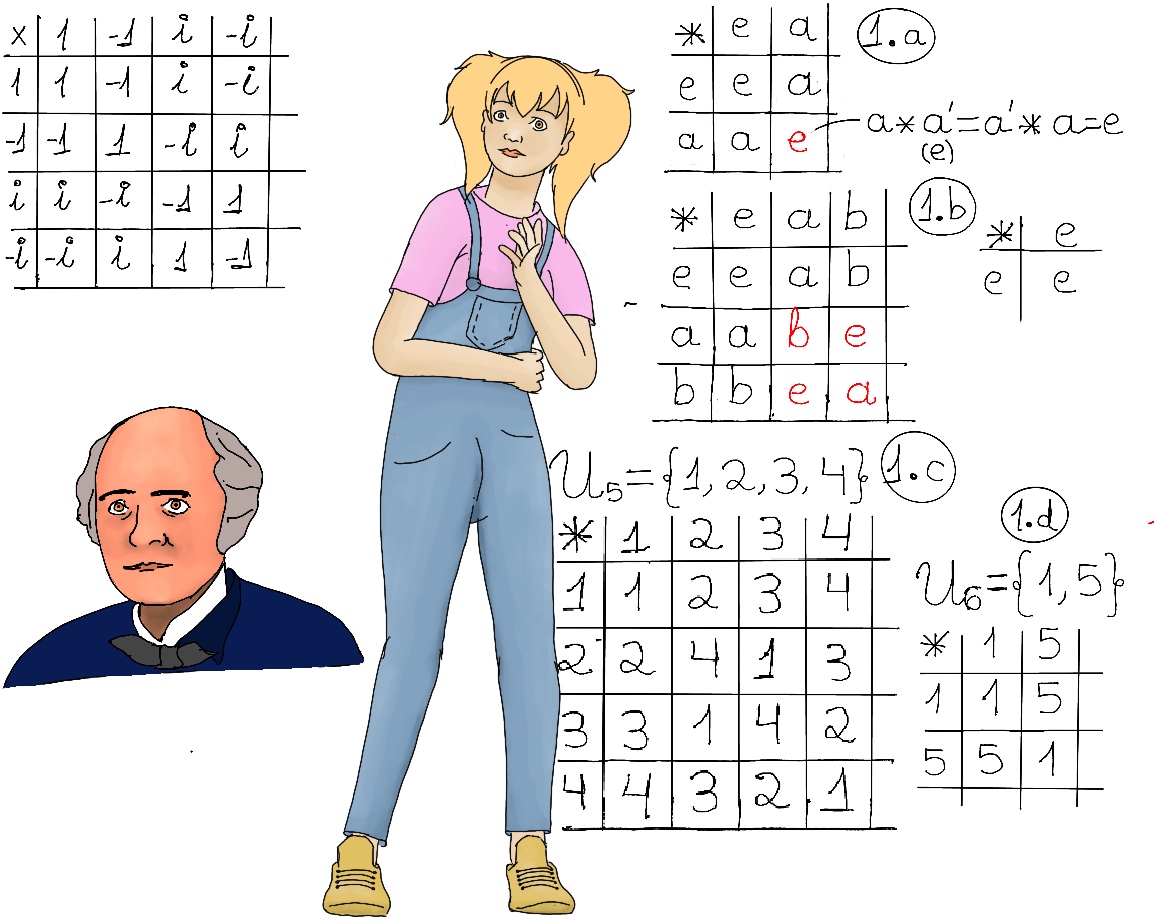
Let’s take into consideration the Cayley table for G ({1, -1, i, -i}, x).
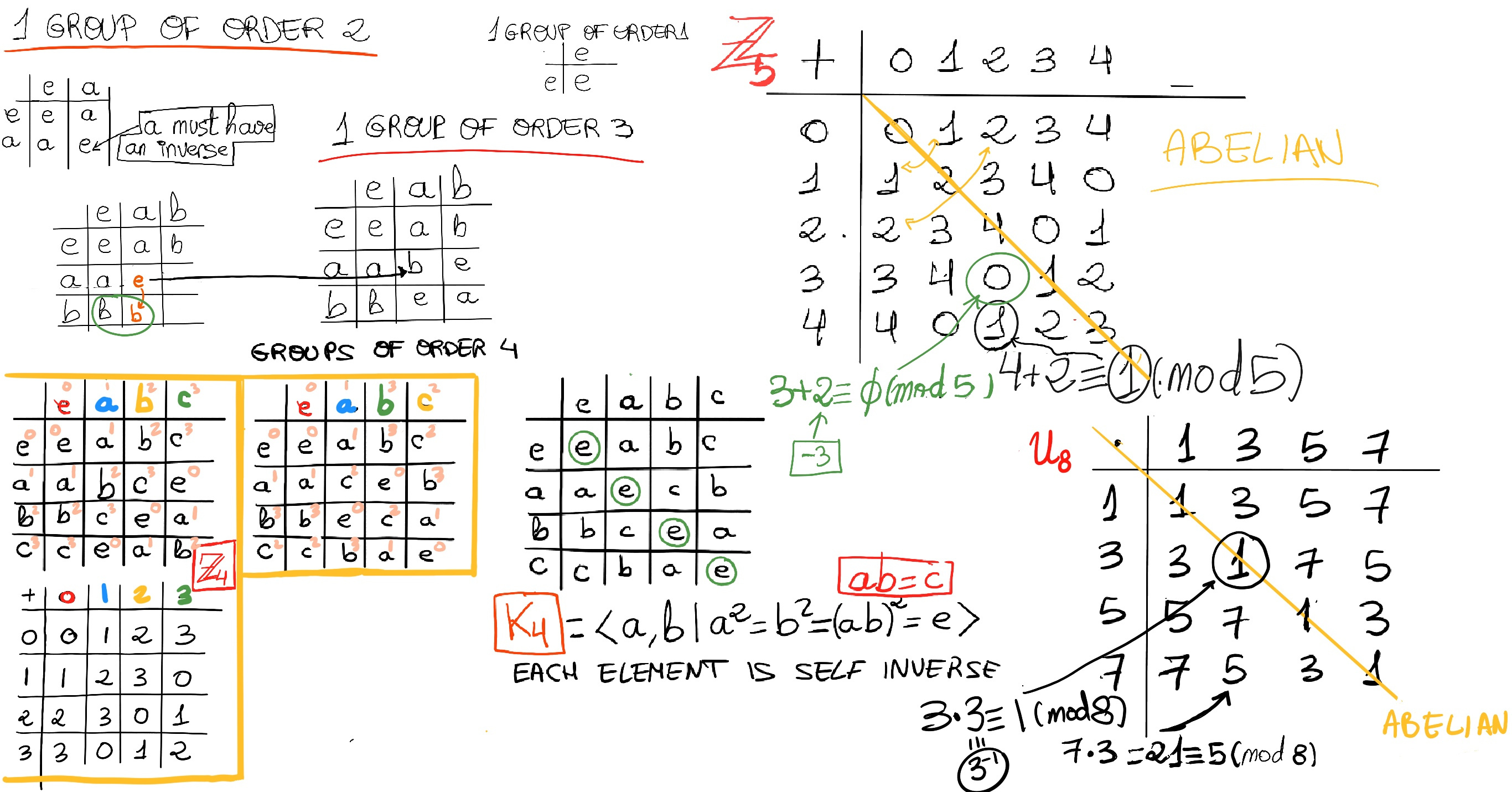
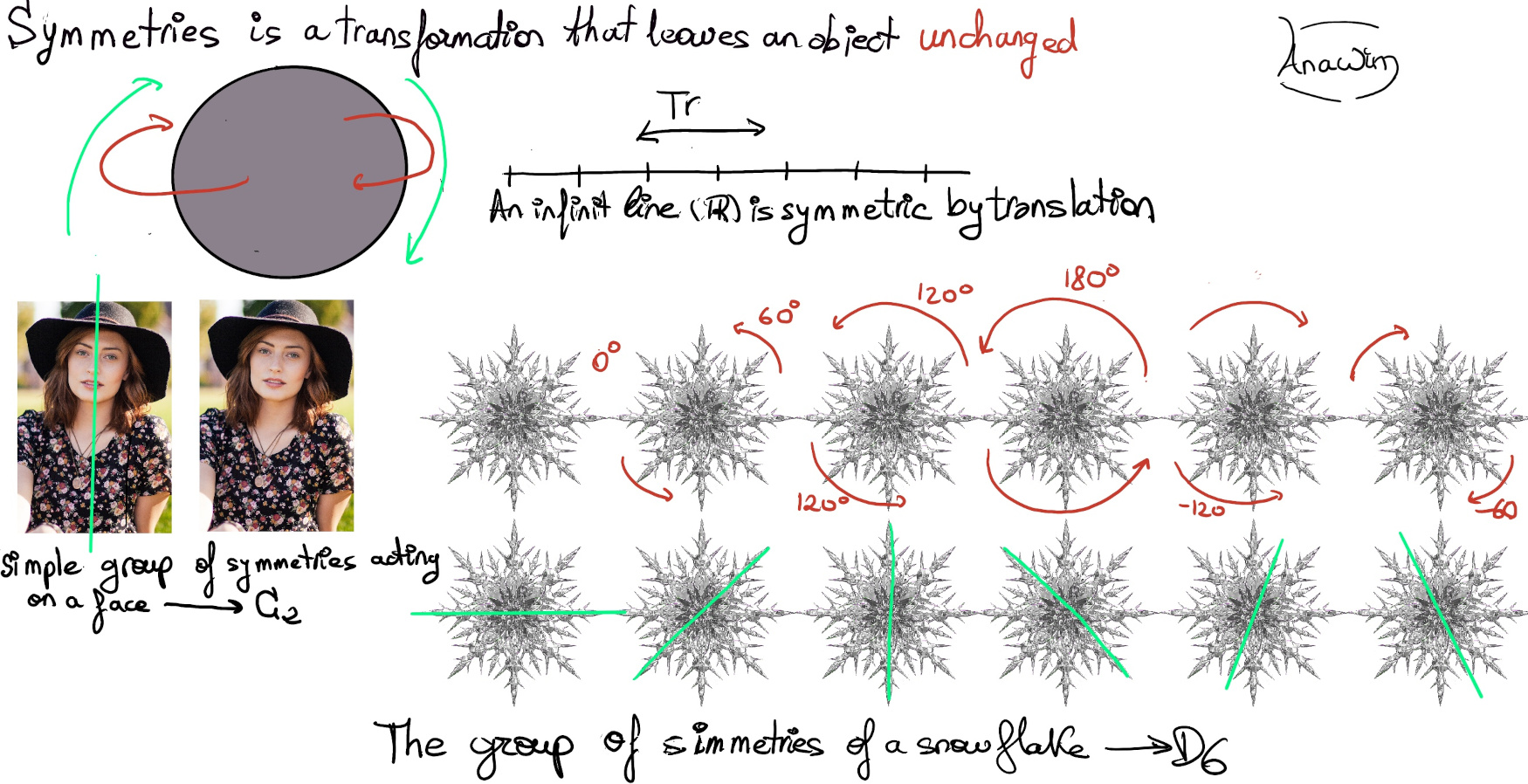
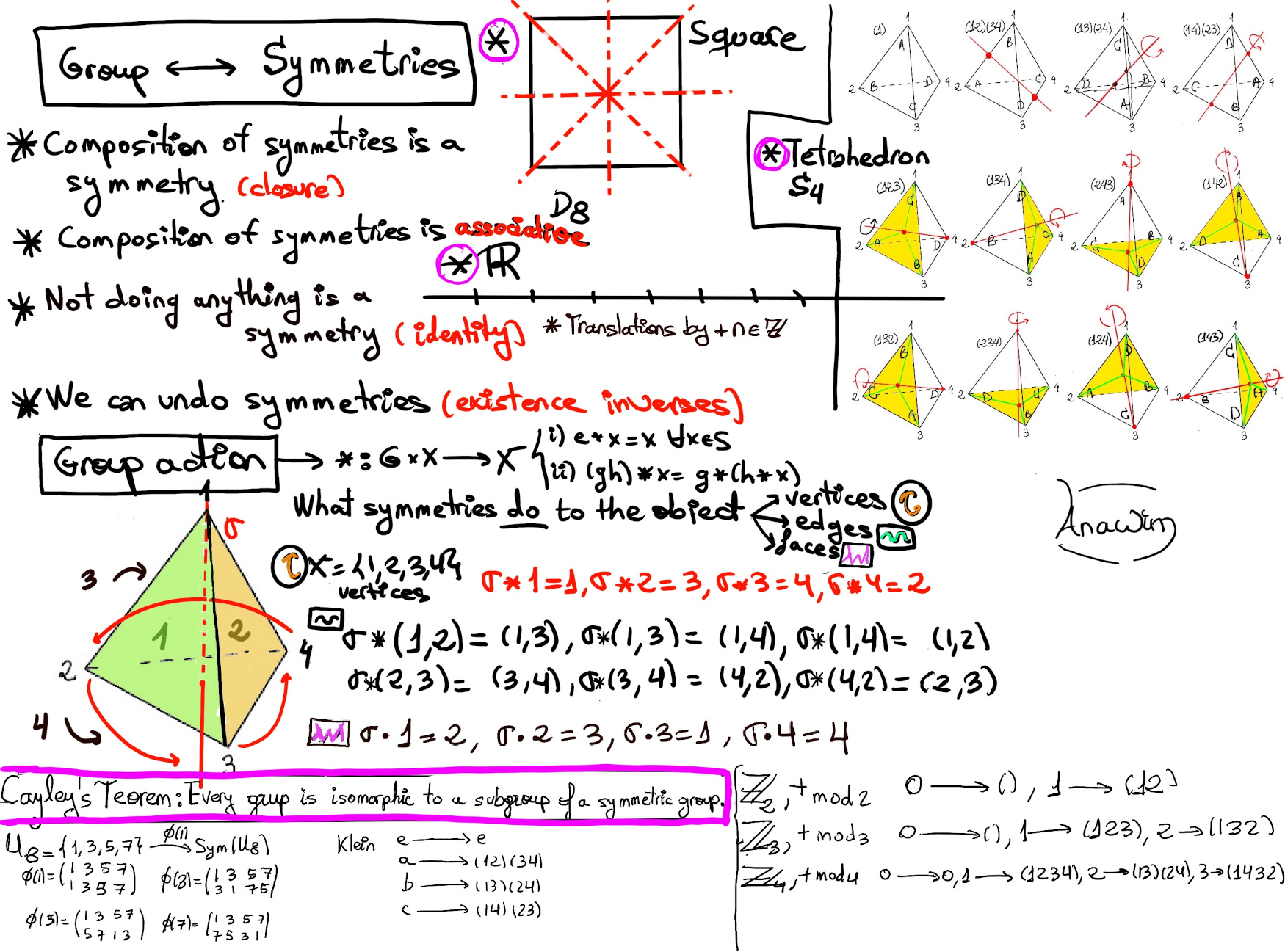
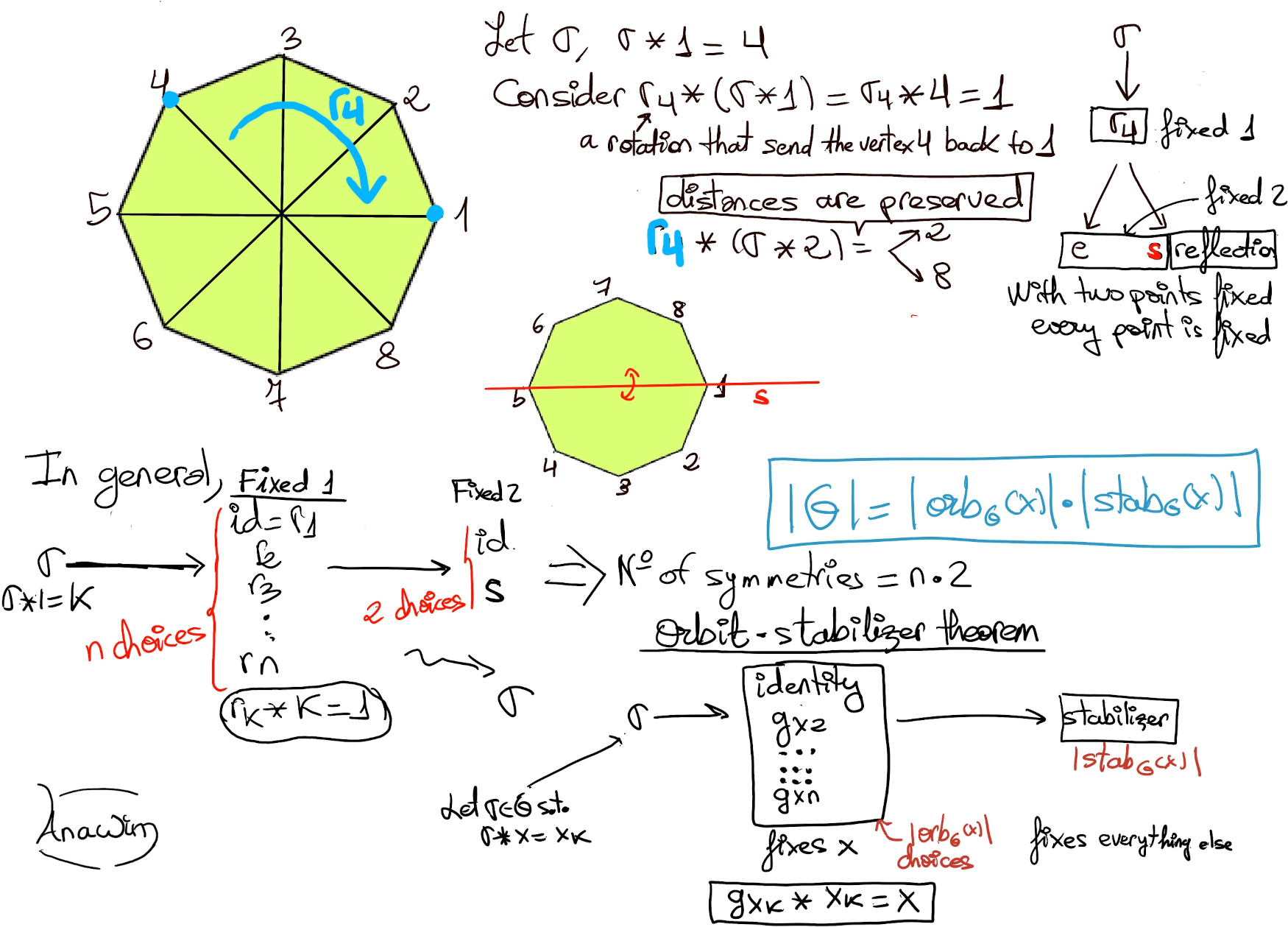
Indeed group theory is the mathematical language of symmetry. We can think groups as symmetries (a transformation that preserves both distances and the object itself). Futhermore, symmetries of an object (a plane figure -square-, a solid figure -tetrahedron- or a real number line ℝ) do form a group (💡Source: Mathemaniac YouTube’s channel, Essence of Group Theory).
Definition. A group action of a group G on a set A, written as g·a or simply ga (g acts on a), is a map or function from G x A to A such that the following two conditions hold:
Proposition. Let the group G act on a set A. For each fixed element of G, say g ∈ G, we get a permutation σg: A → A defined by σg(a) = g·a. Besides, the map from Φ: G → SA defined by g → σg is a homomorphism. It is called the permutation representation associated to the given action.
Proof. We know that the map f: A → B is a bijection if and only if there exists g: B → A, the inverse of f, such that f∘g is the identity map on B and g∘f is the identity map on A.
∀g ∈ G, ∃g-1, we claim that σg-1 is the inverse of σ.
(σg-1∘σg)(a) = [By definition of function composition] σg-1(σg(a)) = σg-1(g·a) = g-1·(g·a) = [By property 1 of a group action] (g-1g)·a = e·a = [By property 2 of a group action] a
Since g was chosen arbitrary, we may interchange the roles of g and g-1 ⇒ σg is a permutation of A.
is the map Φ: G → SA a homomorphism? We have already proved that σg ∈ SA.
Φ(g1g2) = Φ(g1)∘Φ(g2)?
∀a ∈ A, Φ(g1g2)(a) = σg1g2(a) = (g1g2)·a = [By property 1 of an action] g1·(g2·a) = σg1(σg2(a)) = (Φ(g1)∘Φ(g2))(a)
Basically, a group action just means that every element g in G acts as a permutation on A in a way that is consistent with the group operation in G. Let Φ: G → SA be any homomorphism from a group G to the symmetric group on a set, then the map from G x A to A defined by ∀g ∈ G, a ∈ A, g·a = Φ(g)(a) is a group action of G on A, and therefore actions on a group and homomorphisms from this group into the symmetric group SA are basically the same construct or, more formally, in bijective correspondence.
Examples:
Definition. If G acts on a set A and distinct elements of G induce distinct permutations of A, that is, when g1 ≠ g2 in G, there is an a ∈ A such that g1·a ≠ g2·a, the action is called faithful. The kernel of the action of G on A is {g ∈ G | ga = a ∀a ∈ A}
The symmetric group (G =) SA acting on A, SA x A → A, by σ·a = σ(a) ∀σ ∈ SA, a ∈ A. The associated permutation representation Φ: SA → SA is the identity map.
We can make ℝn act on itself by translations, for v ∈ ℝn, let Tv: ℝn → ℝn, defined by Tv(w) = w + v. The axioms for a group action are: T0(w) = w and Tv1(Tv2(w)) = Tv1+v2(w). These are true properties of vector addition: w + 0 = w, (w + v2) + v1 = w + (v1 + v2).
For n ≥ 3, Dn acts on a regular n-gon as rigid motions. We can also view Dn as acting just on the n vertices of a regular n-gon. This does not lose any information at all, since knowing where each and every vertex go under a rigid motion determines completely where everything else goes. By focusing on the action of Dn on the n vertices, and labelling them by 1, 2, ···, n, we make Dn act on {1, 2, ···, n} (See the previous illustration).
We can make G act on itself by left multiplication. We let A = G and g·a = ga is merely the usual product of g and a in G.
Let G = ℤ/4ℤ act on itself by additions. For instance, addition by 1 has the effect 0 → 1 → 2 → 3 → 0. Addition by 1 on ℤ/4ℤ is a 4-cycle (0123). Addition by 2 has the effect 0 → 2 → 4, 1 → 3, it is a product of two 2-cycles, (02)(13). The composition of these two permutations is (0123)(02)(13) = (0321) which is the permutation of G described by addition by 3.